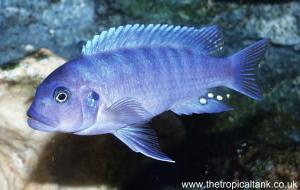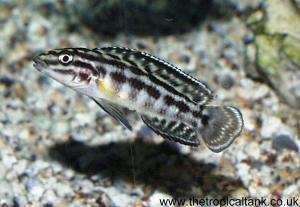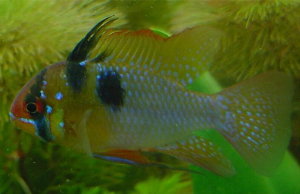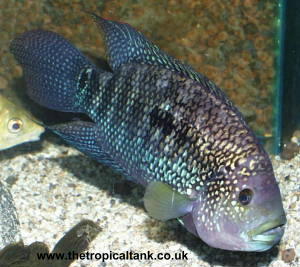

Photos taken at Wharf Aquatics
Photos © Sean Evans
|
| Common name: | Gold ocellatus |
| Scientific name: | "Lamprologus" ocellatus (see note on Lamprologus ) |
| Synonyms: | (none) |
| Size: | 2" (5cm), female smaller. |
| Origin: | Lake Tanganyika, East Africa |
| Tank setup: | Sand substrate (or very fine gravel), and lots of shells. A few small rocks can be added in the background. |
| Compatibility: | Best kept in a group in a small species tank. Alternatively, keep in a larger tank with
other Tanganyikan cichlids which are not overly aggressive towards other species, such as Altolamprologus,
Julidochromis, etc. |
| Temperature: | 24-27oC (75-81oF) |
| Water chemistry: | Hard and alkaline: pH 7.8-9.0, GH 12-20, KH 14-20 ideally, but at least 6. |
| Feeding: | Will take most aquarium foods, but small frozen or live foods are ideal. |
| Sexing: | Mature males are larger, so size can serve as a rough guide when attempting to select a pair
or a balanced group of juveniles. There may also be differences in colour on the dorsal and anal fins, with white edges
on the female and gold on the male. |
| Breeding: | Ideally, keep more females than males. Males may spawn with more than one female.
Each fish will occupy its own shell, but spawning takes place inside the shell of the female.
The first indication that spawning has occured is likely to be the presence of fry near to the entrance to the chosen shell.
The fry are very tiny and will therefore require the smallest of available foods initially. |
| Comments: |
The colour variant referred to as "Gold" (see photo above right) is a popular shelldweller originating from Nkamba Bay, Zambia.
These fish will vigorously defend their territory against larger cichlids, and are more assertive than their size would predict.
In the wild, these fish occur where many shells of the Neothauma snails are present. In captivity, any similarly-shaped
shells will suffice, such as those from the apple snail. Maintain high water quality with small, frequent partial water changes.
|









